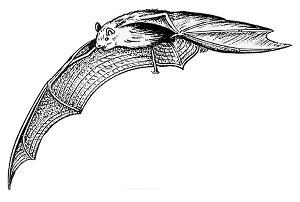Factsheet
Bat (Pipistrelle)
The pipistrelle is the smallest and most common of Britain's 18 species of bat. It belongs to the Vespertilionidae family of bats, known as ordinary or earlet bats, and appears earlier in the evening than most other bats.
Overview
 Order: Chiroptera
Order: Chiroptera
Family: Vespertilionidae
Species: Pipistrellus pipistrellus
IUCN Red List Status: Least concern, though numbers are declining in UK
Size: Length : 3-5cm (head and body)
Wingspan: 19-25cm
Weight: 3-9g
Life-span: Average life is 4-5 years. Maximum life-span recorded is 11 years.
Distribution: British Isles and continental Europe (except the far north), south west Asia, north-eastwards to Korea and Japan and east to Kashmir, and also Morocco.
Food: A wide variety of small, flying insects.
Habitat: A wide range of habitats, including mature woodlands, wetlands, grasslands, farms, parks and gardens. Prefers open grassy areas surrounded by trees or bushes. Often seen flying low over water.
Description: A tiny body, short legs, broad flat head; short, broad ears, fairly narrow wings and a short tail. Adults vary in colour from place to place, some colonies are mainly orange-brown and others mainly pale grey-brown. Ears and muzzle are dark.
Pipistrelle Habits
Pipistrelle bats gather together in colonies throughout the year. During the summer they congregate in large colonies, roosting in trees (under bark or in hollows), buildings such as churches, and rock crevices.
Favourite summer roosting places are small, warm spaces behind tiles or weather-boarding on a south-facing wall. The pipistrelle is so tiny that it can squeeze through gaps only 15mm wide.
The bats sleep lightly during the day and usually begin streaming out from their roost 15 - 30 minutes before sunset to hunt for insects. In midsummer they regularly appear during the daytime. Each bat spends 2 - 5 hours per day away from its colony, using temporary roosts in between short feeding flights.
Pipistrelle bats hibernate during the winter, from about mid-October. The colony gradually stops feeding and finds a suitable hibernation site, such as a church roof or bell tower, a quiet place in a large house, a hollow tree or rock crevice. Each bat hangs or wedges itself head down, gripping the surface with its feet. During warmer spells, the pipistrelle will wake up and fly out to look for food. Winter colonies sometimes number 1000 bats - one cave in Romania is a refuge for an estimated 100,000 pipistrelles!
Protecting the Pipistrelle
Although the pipistrelle is the most common bat in Britain, it has been declining over the years along with all other bats. The 18 species of British bat are all protected under the Wildlife and Countryside Act. If any of them have made a home in your roof it is against the law to interfere with them. They do no harm to you or your property - so there is no need to worry if you have resident bats!
The widespread use of pesticides drastically reduces insect populations thus depriving bats of food - they may also have eaten insects poisoned with chemicals. Over the years the habitats e.g. hedges, ponds and old grassland, where bats like to hunt have declined in number and they have also lost many of their traditional roosting places, such as hollow trees.
If you would like to find out more about bats and how to help them, visit the The Bat Conservation Trust.
Credits
Image: bat-pipistrelle by Michael Sale
Introduction
The pipistrelle is the smallest and most common of Britain's 18 species of bat. It belongs to the Vespertilionidae family of bats, known as ordinary or earlet bats, and appears earlier in the evening than most other bats. It has a jerky, erratic flight, flickering its wings rapidly as it pursues its prey.
The jerky flight of the pipistrelle gave rise to the ancient name for bats - flittermouse (Fledermaus in German.)
Feeding and flying
The pipistrelle hunts over a regular beat, flying at between 2 - 13 metres, usually up to 6 metres, above the ground. The bat eats mostly gnats, tiny moths and small caddisflies, hunting for them in open spaces around a building or tree, or above water. If a large insect is captured, it is taken to a perch to be eaten. A bat eats several hundred insects every day
When the pipistrelle is flying fast in the dark, it can avoid bumping into obstacles and track down prey by using a system of echo-location, similar to the radar-scanning equipment used in ships and aircraft. The bat frequently emits very high-pitched (ultrasonic) squeaks which bounce back from any solid object into its ears. In each ear there is a fleshy spike, known as a tragus, which receives the sound; the bat is able to interpret the time taken for the echo to return and 'see' its surroundings. A bat probably carries a sound picture of familiar territory, comparable to the visual memory of humans.
Breeding
Mating takes place in the autumn, just before hibernation, but the sperm does not fertilize the female's egg cells until the spring - this is called delayed implantation. Once the embryo starts to grow, its development depends on the weather and the food supply. It will stop developing if conditions are poor.
The female pipistrelles form their own nursery colonies in early summer, often in a roof space behind tiles. The males roost in separate small colonies during the summer, only joining the females during the autumn and winter months.
Gestation is normally 44 - 50 days and usually only one baby is born in June. The baby bats are very tiny, hairless and blind for about a week. Warmth is very important and the warmer they are the faster they grow. The young are weaned and ready to fly independently at 3 weeks old. The females reach sexual maturity in 1 year and the males in 2 years.
 Order: Chiroptera
Order: Chiroptera
